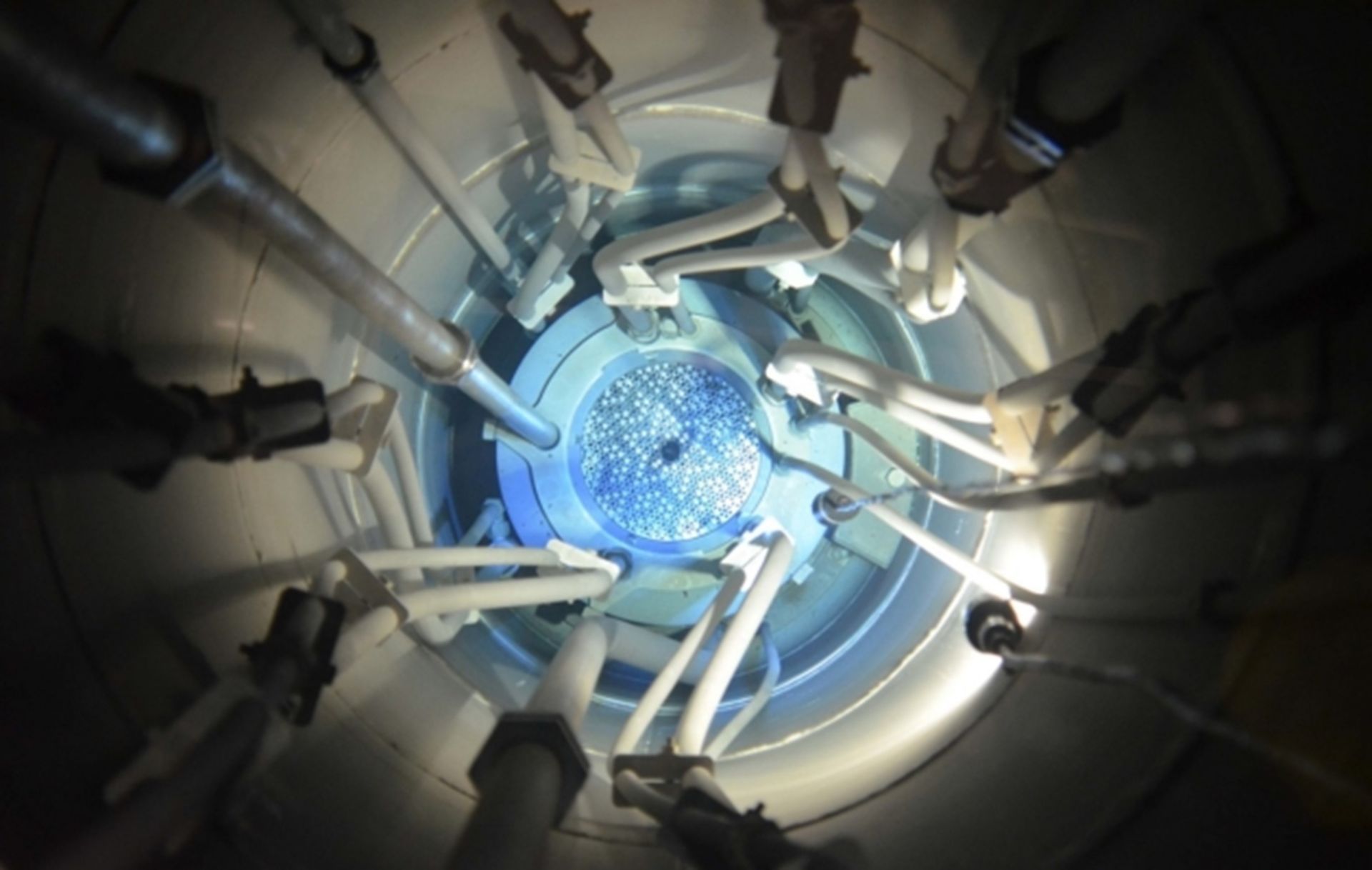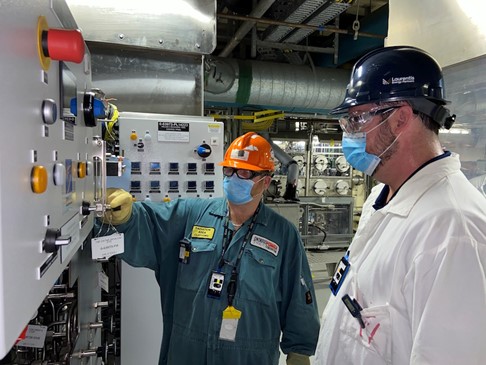The core of SLOWPOKE-2. (Photo: CNL)
Canadian Nuclear Laboratories (CNL) announced on September 23 that it had refueled the SLOWPOKE-2 research reactor at the Royal Military College of Canada (RMC) in Kingston, Ontario. The reactor was recommissioned on September 10 after a 22-day outage.
The EU’s Massimo Garribba (left) and the IAEA’s Lydie Evrard met at last week’s 65th IAEA General Conference to extend a 2013 cooperation agreement. (Photo: C./Silva Villareal)
Some of the major achievements of the nuclear safety cooperation agreement between the International Atomic Energy Agency and the European Union (EU) include more than 100 nuclear safety review missions, environmental remediation at former uranium sites in Central Asia, and more effective radioactive waste management in Africa.
Snow covering grounds of the Texas Capitol on February 15, 2021.
To prevent future winter storms from causing the kind of widespread, lethal power outages wrought by February’s frigid blast through Texas and other states, the electric and natural gas industries need to bolster their winterization and cold weather preparedness and coordination, a just-released preliminary report from the Federal Energy Regulatory Commission and North American Electric Reliability Corporation concludes.
The two agencies had announced on February 16 that they planned to open a joint inquiry to identify problems with the performance of the bulk power system during the storm and to offer solutions. A team of FERC and NERC staff members presented the report at a FERC meeting on September 23.
A presentation of the report, February 2021 Cold Weather Grid Operations: Preliminary Findings and Recommendations, is available.
The U.S. NRC headquarters.
The staff of the Nuclear Regulatory Commission recently released a draft white paper outlining strategies for streamlining microreactor licensing. The paper is to be used to facilitate discussion at an upcoming advanced reactor stakeholder public meeting.
“This paper,” the document emphasizes, “has not been subject to NRC management and legal reviews and approvals, and its contents are subject to change and should not be interpreted as official agency positions.”
(Click photo to enlarge) One of 16 AC100M gas centrifuges built by Centrus Energy for HALEU production in Piketon, Ohio. (Photo: Centrus Energy)
For years, pressure has been building for a commercial path to a stable supply of high-assay low-enriched uranium (HALEU)—deemed essential for the deployment of advanced power reactors—but advanced reactor developers and enrichment companies are still watching and waiting. In contrast, the uranium spot price soared after Sprott Physical Uranium Trust, a Canadian investment fund formed in July, began buying up U3O8 supplies, causing the price to increase over 60 percent, topping $50 per pound for the first time since 2012. Fueled by growing acknowledgment that nuclear power is a necessary part of a clean energy future, uranium is the focus of attention from Wall Street to Capitol Hill.
U.S. energy secretary Jennifer Granholm and IAEA director general Rafael Mariano Grossi pose for a photo before their September 21 meeting announcing the next International Ministerial Conference on Nuclear Power in the 21st Century. (Photo: D. Calma/IAEA)
U.S. energy secretary Jennifer Granholm and International Atomic Energy Agency director general Rafael Mariano Grossi met in Vienna yesterday during the agency’s 65th General Conference to launch preparations for the next IAEA International Ministerial Conference on Nuclear Power in the 21st Century, slated for October 26–28, 2022, in Washington, D.C.
September 20, 2021, 12:04PMNuclear Newsthe Standards Committee An artist’s rendering of the NuScale plant. (Image: NuScale)
For more than two decades, the American Nuclear Society’s Standards Committee has recognized the benefit of incorporating risk-informed and performance-based (RIPB) methodology into ANS standards to improve their effectiveness, efficiency, and transparency. In general, standards using RIPB methods with properly identified and structured objectives need less modification and can be expected to remain valid for much longer periods.
BWXT Canada’s Cambridge, Ontario, facility. (Photo: BWXT Canada)
NuScale Power announced earlier this week that manufacturing process development work on its small modular reactor—the NuScale Power Module—is advancing at BWXT Canada Ltd.’s Cambridge, Ontario, facility in preparation for module fabrication. NuScale said that this work is critical to the development of its SMR technology and is an example of the supply chain development opportunities for Canadian companies with the requisite power plant equipment expertise.
Rendition of the IMSR400 power plant in the configuration proposed for the Darlington site. (Image: Terrestrial Energy)
Terrestrial Energy has upgraded the design of its Integral Molten Salt Reactor (IMSR) nuclear power plant, the company announced on September 14. The proposed facility will now feature 390 MWe of generation capacity for grid supply from twin reactors and generators.
Illinois governor J.B. Pritzker appreciates applause at the signing event for the state's new energy bill.
In an hour-long ceremony held yesterday at Chicago’s Shedd Aquarium amid some fanfare (it included an appearance by lizards, a snake, and a penguin), Illinois Gov. J.B. Pritzker signed into law the Climate and Equitable Jobs Act (S.B. 2408). The bill is a sweeping overhaul of the state’s energy policies aimed at phasing out fossil-fuel power generation and placing Illinois on a path to become a 100 percent carbon-free energy producer by 2050.
Don Perrie (left), of OPG, and Michael Lefebvre, of Laurentis Energy Partners, examine the He-3 extraction tool installed at Darlington NPP
Laurentis Energy Partners, a subsidiary of Ontario Power Generation (OPG), has launched a new program to produce helium-3. The He-3 will be obtained from tritium stored at OPG’s Darlington nuclear power plant, a four-unit CANDU station located about 100 kilometers east of Toronto.
Darlington houses one of the world’s largest reserves of tritium, which is a by-product of the heavy water used in CANDU reactors.
U.S. energy secretary Jennifer Granholm and India’s minister of petroleum and natural gas Hardeep Singh Puri remotely meet (with others in the background) during the virtual launch of a "newly revitalized” U.S.-India clean energy partnership.
U.S. energy secretary Jennifer Granholm and India’s minister of petroleum and natural gas, Hardeep Singh Puri, last week presided over the virtual launch of what the Department of Energy termed the “newly revitalized” U.S.-India Strategic Clean Energy Partnership (SCEP).










 The International Atomic Energy Agency has revised upward its projections regarding the potential growth of nuclear power’s capacity for electricity generation over the next three decades. The upward revision is the first by the IAEA since the Fukushima Daiichi accident in 2011.
The International Atomic Energy Agency has revised upward its projections regarding the potential growth of nuclear power’s capacity for electricity generation over the next three decades. The upward revision is the first by the IAEA since the Fukushima Daiichi accident in 2011.




. of OPG, and Michael Lefebvre, of Laurentis Energy Partners, examine tew He-3 extraction tool installed at Darlington NPP.jpg)
